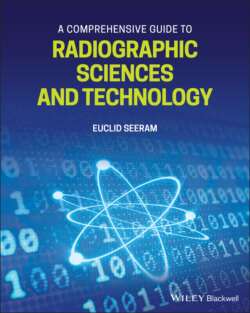Читать книгу A Comprehensive Guide to Radiographic Sciences and Technology - Euclid Seeram - Страница 18
Digital radiographic imaging modalities
ОглавлениеAs listed earlier in this chapter, these modalities include CR, FPDR or DR as it is sometimes referred to, DF, DM, digital radiographic tomosynthesis (DRT), digital breast tomosynthesis (DBT), and last but not least CT. Additionally, since all of the above‐mentioned modalities include image processing using computers, the concepts of Digital Image Processing will be reviewed since it has become an essential tool for technologists, radiologists, and medical physicists working in a digital radiology department.
These imaging modalities include specific physics concepts that must be understood for optimum results. For example, CR is based on the use of photostimulable phosphors (PSP) which are based on the physical principle of photostimulable luminescence (PSL). An example of one such phosphor is barium fluoro halide (BaFX) where the halide (X) can be chlorine (Cl), bromine (Br), iodine (I), or a mixture of them. When the PSP imaging plate (IP) is exposed to x‐rays, electrons are moved from the ground state (valence band) to a higher energy level (conducting band) and are trapped there until the PSP plate is exposed to a laser light and subsequently the electrons in the higher energy state return to their ground state, thus emitting a bluish‐purple light referred to as PSL.
The detectors used in FPDR are based on semiconductor physics. Examples of two such common detectors used in DR are indirect digital detectors which use amorphous silicon photoconductor coupled to an x‐ray scintillator (cesium iodide for example) and direct digital detectors which use amorphous selenium photoconductor. While the former detector converts x‐rays to light which falls upon the silicon photoconductor to produce electrical signals, the latter detector converts x‐rays directly into electrical signals. The other digital imaging modality detectors are based on photoconductor physics.
The imaging modalities listed above convert radiation attenuated by the patient and falling on the digital detector to digital data. This is necessary since computers are used to process these data through popular digital image processing operations. These operations have become commonplace and must be fully understood for effective use in clinical practice. One such tool is the concept of windowing, where the image brightness and contrast can be changed by the operator to suit the viewing needs of the human interpreter. Furthermore, other digital image processing tools that are vital in DBT and CT image reconstruction algorithms. These algorithms have evolved from the filtered back projection (FBP) algorithm to more complex algorithms such as iterative reconstruction (IR) algorithms. These algorithms play an important role in building up an image from data collected through 360° around the patient in CT, for example. Today, IR algorithms are now used by all CT vendors.
